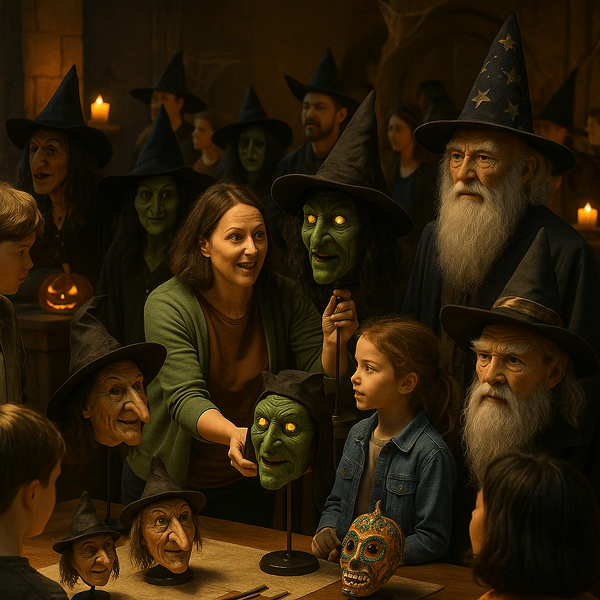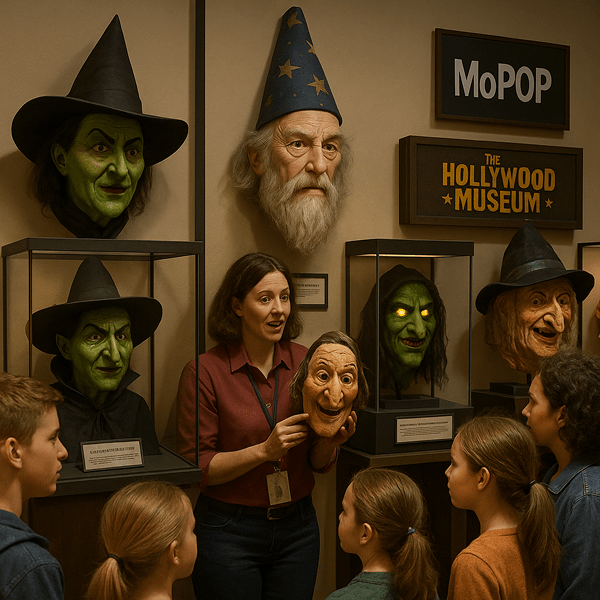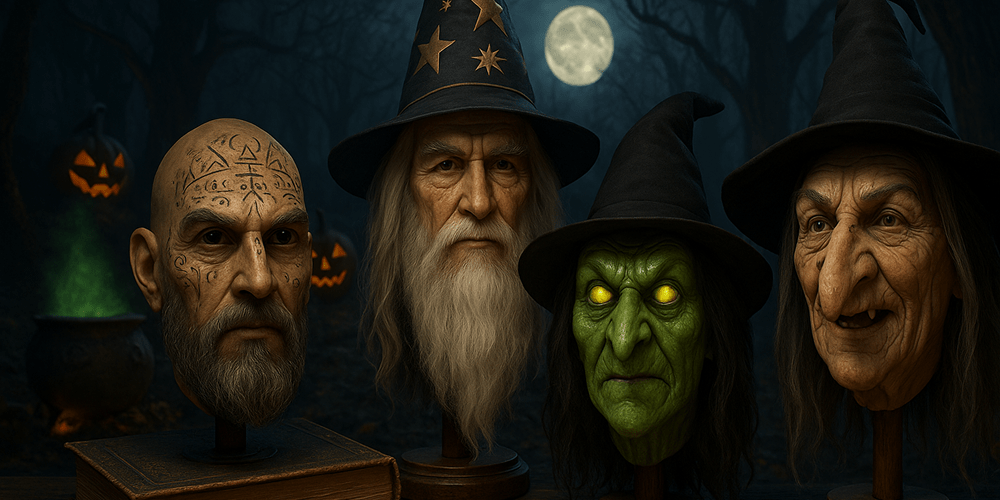Halloween Witch and Wizard Masks are some of the most iconic and recognizable symbols of the Halloween season. These masks transform wearers into mythical spellcasters, evoking centuries of folklore, superstition, and popular culture. Typically, Halloween Witch Masks feature exaggerated hooked noses, warts, crooked teeth, pointed chins, and sometimes a classic pointed hat, while Wizard Masks are often characterized by long white beards, bushy eyebrows, wise eyes, and ornate hats decorated with stars or moons. Materials range from simple plastic or fabric to intricately sculpted latex and silicone, sometimes with attached hair, hats, or mystical accessories. Originating in Western folklore and evolving through literature, theater, and film, Witch and Wizard Masks have become staples in North American and European Halloween celebrations since the 20th century. For a ghostly twist on supernatural masks, see also Ghost Masks, explored in detail on toddmasks.com.
Historical Origins of Halloween Witch and Wizard Masks
The origins of Witch and Wizard Masks are rooted in centuries-old beliefs, rituals, and legends. The word “witch” comes from the Old English “wicce,” meaning “female sorcerer,” while “wizard” originates from the Middle English “wysard,” meaning “wise one.” In medieval Europe, fear of witchcraft and the supernatural led to the creation of folk tales, cautionary art, and public rituals featuring witch figures. The earliest masks depicting witches were used in medieval pageants, festivals, and morality plays, often to warn against evil or mock superstition.
The evolution of the wizard mask is closely tied to literary and theatrical traditions, with wizards portrayed as wise elders, alchemists, or magicians in both folklore and stage productions. The Renaissance and Enlightenment eras further popularized the wizard archetype, culminating in famous literary characters like Merlin and later, Gandalf and Dumbledore.
By the 19th and 20th centuries, Halloween in the United States and Britain adopted the imagery of witches and wizards for costumes and masks, influenced by the rise of horror fiction, the occult revival, and Hollywood films such as “The Wizard of Oz” and “Hocus Pocus.” Modern mask-making techniques enabled mass production, making these characters accessible to all.
Cultural Significance and Symbolism of Halloween Witch and Wizard Masks
Halloween Witch and Wizard Masks are rich in symbolism, embodying humanity’s fascination with magic, mystery, and transformation. In Western cultures, witches often symbolize fear of the unknown, subversive power, or misunderstood wisdom, while wizards represent knowledge, guidance, and the ability to transcend natural laws.
Spiritually, witch masks can reference ancient pagan traditions, goddess worship, or the duality of good and evil. Wizard masks evoke alchemy, the search for enlightenment, and the archetype of the wise mentor. Myths and legends abound: from the wicked witch of fairy tales to the wise wizard of Arthurian lore, these masks carry stories of ambition, danger, redemption, and transformation.

Socially, wearing a witch or wizard mask at Halloween allows participants to explore hidden aspects of identity, challenge norms, and engage in playful role reversal. The use of masks in rituals, theater, and community celebrations reinforces their connection to both personal and collective imagination.
Materials and Crafting Techniques of Halloween Witch and Wizard Masks
Witch and Wizard Masks are made using a variety of traditional and modern materials:
- Latex and silicone: For detailed, flexible, and realistic masks.
- Plastic and vinyl: Lightweight, affordable, and suitable for mass production.
- Fabric and felt: Used for simple masks, hats, and beards.
- Papier-mâché and resin: For hand-crafted, custom, or collectible masks.
- Hair, yarn, and synthetic fibers: For beards, eyebrows, and warts.
The crafting process typically involves:
- Sculpting the original face in clay or digitally
- Creating a mold for casting latex or silicone
- Painting and airbrushing for lifelike features
- Attaching accessories such as hats, hair, glasses, or magical props
- Adding elastic bands, ribbons, or handles for wearing
Special techniques include hand-painting, glow-in-the-dark effects, and animatronic features (moving eyes, mouths, or sound effects). Regional differences exist, with American masks focusing on horror or fantasy, while European masks may reflect historical or folk motifs. Color symbolism is also important: black for mystery, green for wickedness or magic, white or silver for wisdom, and purple or gold for royalty and power.
For deeper insights and mask-maker stories, visit toddmasks.com.
Functions and Uses of Halloween Witch and Wizard Masks
Witch and Wizard Masks serve a variety of functions:
- Ritual and Ceremonial Use: Echo ancient Halloween and Samhain traditions of disguising oneself to ward off spirits or invoke magical power.
- Theatrical and Performance Use: Central to plays, parades, haunted houses, and community events.
- Festival and Holiday Use: Worn at Halloween parties, trick-or-treating, and themed events by children and adults alike.
- Modern Application: Featured in cosplay, fantasy conventions, viral videos, art installations, and educational programs.
Over time, the use of these masks has shifted from ritual protection and moral storytelling to entertainment, parody, and creative expression.
Regional Variations of Halloween Witch and Wizard Masks
Regional styles add diversity to witch and wizard masks:
- United States and UK: Emphasis on the classic “wicked witch” with green skin, warts, and pointed hats, or the wise wizard with flowing beard and staff.
- Europe: Folk variations, such as the Swiss Hexen masks with wooden features or Eastern European Baba Yaga masks with exaggerated noses and chins.
- Latin America: Incorporation of local magical figures or syncretic elements from Day of the Dead traditions.
- Asia: Japanese masks sometimes blend witch or sorcerer imagery with yokai or Noh theater influences.
Each region brings unique materials, motifs, and stories, creating a global tapestry of magical mask design.
Famous Examples and Notable Collections of Witch and Wizard Masks
Notable witch and wizard masks can be found in:
- Hollywood memorabilia collections: Masks from films like “The Wizard of Oz,” “Harry Potter,” and “Hocus Pocus.”
- Museums: The Museum of Pop Culture (MoPOP) in Seattle, The Hollywood Museum in Los Angeles, and international folk art museums.
- Private collections: Artist-signed, hand-crafted masks and rare vintage Halloween masks.
- Online galleries: Digital collections and mask exhibitions available at toddmasks.com.
Historic finds include early 20th-century papier-mâché masks, screen-used film props, and rare European folk masks.

Influence of Halloween Witch and Wizard Masks on Art and Culture
Halloween Witch and Wizard Masks have had a profound influence on visual arts, literature, theater, film, and fashion. Their forms inspire painters, sculptors, and costume designers worldwide. In literature, these masks symbolize transformation, hidden knowledge, and the boundary between reality and fantasy.
In theater and cinema, witch and wizard masks are used to create memorable characters and evoke atmosphere, from Shakespeare’s “Macbeth” to contemporary fantasy epics. In fashion, designer collections often reference magical motifs, while musicians and performers use masks to create dramatic stage personas. Their continued presence in Halloween and pop culture ensures their lasting impact.
Contemporary Status and Preservation of the Witch and Wizard Mask Tradition
Today, the tradition of witch and wizard mask-making is alive and well. Artisans and studios experiment with new materials, 3D printing, eco-friendly latex, and digital sculpting. Online tutorials, maker communities, and workshops help new generations learn the craft.
Masks remain popular in haunted attractions, fantasy festivals, art exhibits, and virtual experiences. Museums, educational programs, and platforms like toddmasks.com play a vital role in preserving the history, artistry, and social meaning of witch and wizard masks.
Collecting and Acquiring Halloween Witch and Wizard Masks
The market for witch and wizard masks spans from inexpensive costume shop items to rare, artist-signed, or screen-used collectibles. Authentic masks can be found at specialty stores, conventions, auctions, and reputable online platforms such as toddmasks.com. Value is influenced by:
- Material and craftsmanship
- Artistic reputation and uniqueness
- Association with films, events, or famous designers
- Provenance and documentation
Collectors should seek quality, originality, and ethical acquisition, supporting living artisans and respecting cultural traditions.
